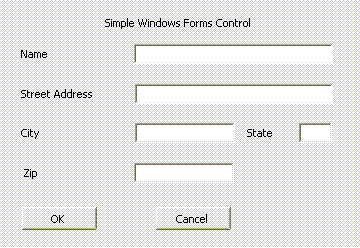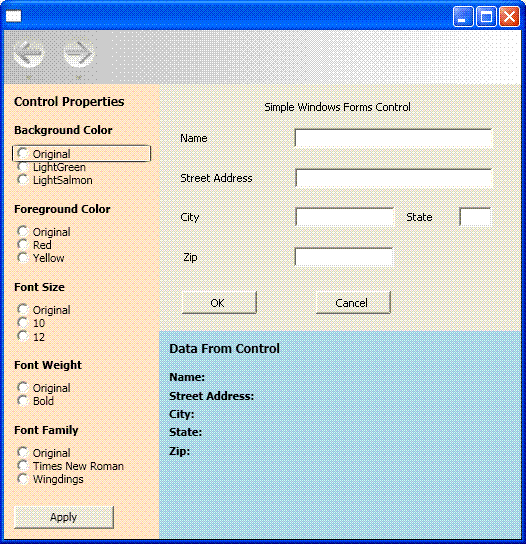チュートリアル: WPF での Windows フォーム複合コントロールのホスト
Windows Presentation Foundation (WPF) は、アプリケーションを作成するための豊富な環境を提供します。 ただし、Windows フォーム コードに多額の投資がある場合は、WPF アプリケーションでそのコードの少なくとも一部を再利用する方が、最初から書き直すよりも効果的です。 最も一般的なシナリオは、既存の Windows フォーム コントロールがある場合です。 場合によっては、これらのコントロールのソース コードにアクセスできない場合もあります。 WPF には、WPF アプリケーションでこのようなコントロールをホストするための簡単な手順が用意されています。 たとえば、特殊な DataGridView コントロールをホストしながら、ほとんどのプログラミングに WPF を使用できます。
このチュートリアルでは、WPF アプリケーションでデータ入力を実行する Windows フォーム複合コントロールをホストするアプリケーションについて説明します。 複合コントロールは DLL にパッケージ化されています。 この一般的な手順は、より複雑なアプリケーションとコントロールに拡張できます。 このチュートリアルは、外観と機能が、Windows フォームで WPF 複合コントロールをホストする
このチュートリアルは、2 つのセクションに分かれています。 最初のセクションでは、Windows フォーム複合コントロールの実装について簡単に説明します。 2 番目のセクションでは、WPF アプリケーションで複合コントロールをホストし、コントロールからイベントを受信し、コントロールのプロパティの一部にアクセスする方法について詳しく説明します。
このチュートリアルで説明するタスクは次のとおりです。
Windows フォーム複合コントロールの実装。
WPF ホスト アプリケーションの実装。
このチュートリアルで示すタスクの完全なコード一覧については、「WPF サンプルでの Windows フォーム複合コントロールのホスト
前提 条件
このチュートリアルを完了するには、Visual Studio が必要です。
Windows フォーム複合コントロールの実装
この例で使用する Windows フォーム複合コントロールは、単純なデータ入力フォームです。 このフォームは、ユーザーの名前とアドレスを取得し、カスタム イベントを使用してその情報をホストに返します。 次の図は、レンダリングされたコントロールを示しています。
次の図は、Windows フォーム複合コントロールを示しています。

プロジェクトの作成
プロジェクトを開始するには:
Visual Studio を起動し、[新しいプロジェクト] ダイアログ ボックスを開きます。
[ウィンドウ] カテゴリで、Windows フォーム コントロール ライブラリ テンプレート
を選択します。 新しいプロジェクトに
MyControls名前を付けます。場所には、
WpfHostingWindowsFormsControlなど、便利な名前の最上位フォルダーを指定します。 後で、このフォルダーにホスト アプリケーションを配置します。[OK] をクリックしてプロジェクトを作成します。 既定のプロジェクトには、
UserControl1という名前のコントロールが 1 つ含まれています。ソリューション エクスプローラーで、
UserControl1の名前をMyControl1に変更します。
プロジェクトには、次のシステム DLL への参照が必要です。 これらの DLL のいずれかが既定で含まれていない場合は、プロジェクトに追加します。
システム
System.Data
System.Drawing
System.Windows.Forms
System.Xml
フォームへのコントロールの追加
フォームにコントロールを追加するには:
- デザイナーで
MyControl1を開きます。
フォームに、5 つの Label コントロールとそれに対応する TextBox コントロールを、上の図のようにサイズ設定して配置します。 この例では、TextBox コントロールには次の名前が付けられています。
txtNametxtAddresstxtCitytxtStatetxtZip
Button コントロールを 2 つ追加し、それぞれに OK と キャンセルのラベルを付けます。 この例では、ボタン名はそれぞれ btnOK と btnCancelです。
サポート コードの実装
コード ビューでフォームを開きます。 コントロールは、カスタム OnButtonClick イベントを発生させて、収集されたデータをホストに返します。 データはイベント引数オブジェクトに含まれています。 次のコードは、イベントとデリゲートの宣言を示しています。
MyControl1 クラスに次のコードを追加します。
public delegate void MyControlEventHandler(object sender, MyControlEventArgs args);
public event MyControlEventHandler OnButtonClick;
Public Delegate Sub MyControlEventHandler(ByVal sender As Object, ByVal args As MyControlEventArgs)
Public Event OnButtonClick As MyControlEventHandler
MyControlEventArgs クラスには、ホストに返される情報が含まれています。
フォームに次のクラスを追加します。
public class MyControlEventArgs : EventArgs
{
private string _Name;
private string _StreetAddress;
private string _City;
private string _State;
private string _Zip;
private bool _IsOK;
public MyControlEventArgs(bool result,
string name,
string address,
string city,
string state,
string zip)
{
_IsOK = result;
_Name = name;
_StreetAddress = address;
_City = city;
_State = state;
_Zip = zip;
}
public string MyName
{
get { return _Name; }
set { _Name = value; }
}
public string MyStreetAddress
{
get { return _StreetAddress; }
set { _StreetAddress = value; }
}
public string MyCity
{
get { return _City; }
set { _City = value; }
}
public string MyState
{
get { return _State; }
set { _State = value; }
}
public string MyZip
{
get { return _Zip; }
set { _Zip = value; }
}
public bool IsOK
{
get { return _IsOK; }
set { _IsOK = value; }
}
}
Public Class MyControlEventArgs
Inherits EventArgs
Private _Name As String
Private _StreetAddress As String
Private _City As String
Private _State As String
Private _Zip As String
Private _IsOK As Boolean
Public Sub New(ByVal result As Boolean, ByVal name As String, ByVal address As String, ByVal city As String, ByVal state As String, ByVal zip As String)
_IsOK = result
_Name = name
_StreetAddress = address
_City = city
_State = state
_Zip = zip
End Sub
Public Property MyName() As String
Get
Return _Name
End Get
Set
_Name = value
End Set
End Property
Public Property MyStreetAddress() As String
Get
Return _StreetAddress
End Get
Set
_StreetAddress = value
End Set
End Property
Public Property MyCity() As String
Get
Return _City
End Get
Set
_City = value
End Set
End Property
Public Property MyState() As String
Get
Return _State
End Get
Set
_State = value
End Set
End Property
Public Property MyZip() As String
Get
Return _Zip
End Get
Set
_Zip = value
End Set
End Property
Public Property IsOK() As Boolean
Get
Return _IsOK
End Get
Set
_IsOK = value
End Set
End Property
End Class
ユーザーが [IsOK プロパティです。 このプロパティを使用すると、どのボタンがクリックされたかをホストが判断できます。 [OK] ボタンは true に設定され、[キャンセル] ボタンは false に設定されます。 次のコードは、2 つのボタン ハンドラーを示しています。
MyControl1 クラスに次のコードを追加します。
private void btnOK_Click(object sender, System.EventArgs e)
{
MyControlEventArgs retvals = new MyControlEventArgs(true,
txtName.Text,
txtAddress.Text,
txtCity.Text,
txtState.Text,
txtZip.Text);
OnButtonClick(this, retvals);
}
private void btnCancel_Click(object sender, System.EventArgs e)
{
MyControlEventArgs retvals = new MyControlEventArgs(false,
txtName.Text,
txtAddress.Text,
txtCity.Text,
txtState.Text,
txtZip.Text);
OnButtonClick(this, retvals);
}
Private Sub btnOK_Click(ByVal sender As Object, ByVal e As System.EventArgs) Handles btnOK.Click
Dim retvals As New MyControlEventArgs(True, txtName.Text, txtAddress.Text, txtCity.Text, txtState.Text, txtZip.Text)
RaiseEvent OnButtonClick(Me, retvals)
End Sub
Private Sub btnCancel_Click(ByVal sender As Object, ByVal e As System.EventArgs) Handles btnCancel.Click
Dim retvals As New MyControlEventArgs(False, txtName.Text, txtAddress.Text, txtCity.Text, txtState.Text, txtZip.Text)
RaiseEvent OnButtonClick(Me, retvals)
End Sub
アセンブリに厳密な名前を付け、アセンブリをビルドする
このアセンブリを WPF アプリケーションによって参照するには、厳密な名前が必要です。 厳密な名前を作成するには、Sn.exe を使用してキー ファイルを作成し、プロジェクトに追加します。
Visual Studio コマンド プロンプトを開きます。 これを行うには、
[スタート] メニューをクリックし、[すべてのプログラム]、[Microsoft Visual Studio 2010/Visual Studio ツール]、[Visual Studio コマンド プロンプト]のを選択します。 これにより、カスタマイズされた環境変数を含むコンソール ウィンドウが起動します。 コマンド プロンプトで、
cdコマンドを使用してプロジェクト フォルダーに移動します。次のコマンドを実行して、MyControls.snk という名前のキー ファイルを生成します。
Sn.exe -k MyControls.snkプロジェクトにキー ファイルを含めるには、ソリューション エクスプローラーでプロジェクト名を右クリックし、[プロパティ]
クリックします。 プロジェクト デザイナーで、[署名] タブをクリックし、[アセンブリに署名] チェックボックスをオンにして、キー ファイルを参照します。 ソリューションをビルドします。 ビルドでは、MyControls.dllという名前の DLL が生成されます。
WPF ホスト アプリケーションの実装
WPF ホスト アプリケーションは、WindowsFormsHost コントロールを使用して MyControl1をホストします。 アプリケーションは、コントロールからデータを受信する OnButtonClick イベントを処理します。 また、WPF アプリケーションからコントロールのプロパティの一部を変更できるオプション ボタンのコレクションもあります。 次の図は、完成したアプリケーションを示しています。
次の図は、WPF アプリケーションに埋め込まれたコントロールを含む、完全なアプリケーションを示しています。

プロジェクトの作成
プロジェクトを開始するには:
Visual Studio を開き、[新しいプロジェクト]を選択します。
[ウィンドウ] カテゴリで、WPF アプリケーション テンプレートを選択します。
新しいプロジェクトに
WpfHost名前を付けます。この場所には、MyControls プロジェクトを含む同じ最上位フォルダーを指定します。
[OK] をクリックしてプロジェクトを作成します。
また、MyControl1 およびその他のアセンブリを含む DLL への参照を追加する必要があります。
ソリューション エクスプローラーでプロジェクト名を右クリックし、[参照の追加]
選択します。 [参照] タブをクリックし、MyControls.dllを含むフォルダーを参照します。 このチュートリアルでは、このフォルダーは MyControls\bin\Debug です。
[MyControls.dll] を選択し、次に [OK] をクリックします。
WindowsFormsIntegration.dllという名前の WindowsFormsIntegration アセンブリへの参照を追加します。
基本レイアウトの実装
ホスト アプリケーションのユーザー インターフェイス (UI) は MainWindow.xaml に実装されます。 このファイルには、レイアウトを定義し、Windows フォーム コントロールをホストする拡張アプリケーション マークアップ言語 (XAML) マークアップが含まれています。 アプリケーションは、次の 3 つのリージョンに分かれています。
コントロールのプロパティ パネルには、ホストされているコントロールのさまざまなプロパティを変更するために使用できるオプション ボタンのコレクションが含まれています。
コントロールからのデータ パネル。ホストされたコントロールから返されたデータを表示するいくつかの TextBlock 要素が含まれています。
ホストされたコントロール自体。
基本的なレイアウトを次の XAML に示します。 この例では、MyControl1 をホストするために必要なマークアップは省略されていますが、後で説明します。
MainWindow.xaml の XAML を次のように置き換えます。 Visual Basic を使用している場合は、クラスを x:Class="MainWindow"に変更します。
<Window xmlns="http://schemas.microsoft.com/winfx/2006/xaml/presentation"
xmlns:x="http://schemas.microsoft.com/winfx/2006/xaml"
x:Class="WpfHost.MainWindow"
xmlns:mcl="clr-namespace:MyControls;assembly=MyControls"
Loaded="Init">
<DockPanel>
<DockPanel.Resources>
<Style x:Key="inlineText" TargetType="{x:Type Inline}">
<Setter Property="FontWeight" Value="Normal"/>
</Style>
<Style x:Key="titleText" TargetType="{x:Type TextBlock}">
<Setter Property="DockPanel.Dock" Value="Top"/>
<Setter Property="FontWeight" Value="Bold"/>
<Setter Property="Margin" Value="10,5,10,0"/>
</Style>
</DockPanel.Resources>
<StackPanel Orientation="Vertical"
DockPanel.Dock="Left"
Background="Bisque"
Width="250">
<TextBlock Margin="10,10,10,10"
FontWeight="Bold"
FontSize="12">Control Properties</TextBlock>
<TextBlock Style="{StaticResource titleText}">Background Color</TextBlock>
<StackPanel Margin="10,10,10,10">
<RadioButton Name="rdbtnOriginalBackColor"
IsChecked="True"
Click="BackColorChanged">Original</RadioButton>
<RadioButton Name="rdbtnBackGreen"
Click="BackColorChanged">LightGreen</RadioButton>
<RadioButton Name="rdbtnBackSalmon"
Click="BackColorChanged">LightSalmon</RadioButton>
</StackPanel>
<TextBlock Style="{StaticResource titleText}">Foreground Color</TextBlock>
<StackPanel Margin="10,10,10,10">
<RadioButton Name="rdbtnOriginalForeColor"
IsChecked="True"
Click="ForeColorChanged">Original</RadioButton>
<RadioButton Name="rdbtnForeRed"
Click="ForeColorChanged">Red</RadioButton>
<RadioButton Name="rdbtnForeYellow"
Click="ForeColorChanged">Yellow</RadioButton>
</StackPanel>
<TextBlock Style="{StaticResource titleText}">Font Family</TextBlock>
<StackPanel Margin="10,10,10,10">
<RadioButton Name="rdbtnOriginalFamily"
IsChecked="True"
Click="FontChanged">Original</RadioButton>
<RadioButton Name="rdbtnTimes"
Click="FontChanged">Times New Roman</RadioButton>
<RadioButton Name="rdbtnWingdings"
Click="FontChanged">Wingdings</RadioButton>
</StackPanel>
<TextBlock Style="{StaticResource titleText}">Font Size</TextBlock>
<StackPanel Margin="10,10,10,10">
<RadioButton Name="rdbtnOriginalSize"
IsChecked="True"
Click="FontSizeChanged">Original</RadioButton>
<RadioButton Name="rdbtnTen"
Click="FontSizeChanged">10</RadioButton>
<RadioButton Name="rdbtnTwelve"
Click="FontSizeChanged">12</RadioButton>
</StackPanel>
<TextBlock Style="{StaticResource titleText}">Font Style</TextBlock>
<StackPanel Margin="10,10,10,10">
<RadioButton Name="rdbtnNormalStyle"
IsChecked="True"
Click="StyleChanged">Original</RadioButton>
<RadioButton Name="rdbtnItalic"
Click="StyleChanged">Italic</RadioButton>
</StackPanel>
<TextBlock Style="{StaticResource titleText}">Font Weight</TextBlock>
<StackPanel Margin="10,10,10,10">
<RadioButton Name="rdbtnOriginalWeight"
IsChecked="True"
Click="WeightChanged">
Original
</RadioButton>
<RadioButton Name="rdbtnBold"
Click="WeightChanged">Bold</RadioButton>
</StackPanel>
</StackPanel>
<WindowsFormsHost Name="wfh"
DockPanel.Dock="Top"
Height="300">
<mcl:MyControl1 Name="mc"/>
</WindowsFormsHost>
<StackPanel Orientation="Vertical"
Height="Auto"
Background="LightBlue">
<TextBlock Margin="10,10,10,10"
FontWeight="Bold"
FontSize="12">Data From Control</TextBlock>
<TextBlock Style="{StaticResource titleText}">
Name: <Span Name="txtName" Style="{StaticResource inlineText}"/>
</TextBlock>
<TextBlock Style="{StaticResource titleText}">
Street Address: <Span Name="txtAddress" Style="{StaticResource inlineText}"/>
</TextBlock>
<TextBlock Style="{StaticResource titleText}">
City: <Span Name="txtCity" Style="{StaticResource inlineText}"/>
</TextBlock>
<TextBlock Style="{StaticResource titleText}">
State: <Span Name="txtState" Style="{StaticResource inlineText}"/>
</TextBlock>
<TextBlock Style="{StaticResource titleText}">
Zip: <Span Name="txtZip" Style="{StaticResource inlineText}"/>
</TextBlock>
</StackPanel>
</DockPanel>
</Window>
最初の StackPanel 要素には、ホストされるコントロールのさまざまな既定のプロパティを変更できる RadioButton コントロールのセットがいくつか含まれています。 その後に、MyControl1をホストする WindowsFormsHost 要素が続きます。 最後の StackPanel 要素には、ホストされたコントロールによって返されるデータを表示する複数の TextBlock 要素が含まれています。 要素と Dock および Height 属性の設定の順序により、ホストされたコントロールがウィンドウに埋め込まれます。ギャップや歪みは発生しません。
コントロールのホスト
前の XAML の次の編集バージョンでは、MyControl1をホストするために必要な要素に焦点を当てています。
<Window xmlns="http://schemas.microsoft.com/winfx/2006/xaml/presentation"
xmlns:x="http://schemas.microsoft.com/winfx/2006/xaml"
x:Class="WpfHost.MainWindow"
xmlns:mcl="clr-namespace:MyControls;assembly=MyControls"
Loaded="Init">
<WindowsFormsHost Name="wfh"
DockPanel.Dock="Top"
Height="300">
<mcl:MyControl1 Name="mc"/>
</WindowsFormsHost>
xmlns 名前空間マッピング属性は、ホストされているコントロールを含む MyControls 名前空間への参照を作成します。 このマッピングを使用すると、XAML で MyControl1 を <mcl:MyControl1>として表すことができるようになります。
XAML の 2 つの要素がホスティングを処理します。
WindowsFormsHostは、WPF アプリケーションで Windows フォーム コントロールをホストできる WindowsFormsHost 要素を表します。MyControl1を表すmcl:MyControl1は、WindowsFormsHost 要素の子コレクションに追加されます。 その結果、この Windows フォーム コントロールは WPF ウィンドウの一部としてレンダリングされ、アプリケーションからコントロールと通信できます。
Code-Behind ファイルの実装
分離コード ファイル (MainWindow.xaml.vbまたはMainWindow.xaml.cs) には、前のセクションで説明した UI の機能を実装する手続き型コードが含まれています。 主なタスクは次のとおりです。
MyControl1のOnButtonClickイベントにイベント ハンドラーをアタッチする。オプション ボタンのコレクションの設定方法に基づいて、
MyControl1のさまざまなプロパティを変更する。コントロールによって収集されたデータを表示します。
アプリケーションの初期化
初期化コードは、ウィンドウの Loaded イベントのイベント ハンドラーに含まれており、コントロールの OnButtonClick イベントにイベント ハンドラーをアタッチします。
MainWindow.xaml.vbまたはMainWindow.xaml.csで、MainWindow クラスに次のコードを追加します。
private Application app;
private Window myWindow;
FontWeight initFontWeight;
Double initFontSize;
FontStyle initFontStyle;
SolidColorBrush initBackBrush;
SolidColorBrush initForeBrush;
FontFamily initFontFamily;
bool UIIsReady = false;
private void Init(object sender, EventArgs e)
{
app = System.Windows.Application.Current;
myWindow = (Window)app.MainWindow;
myWindow.SizeToContent = SizeToContent.WidthAndHeight;
wfh.TabIndex = 10;
initFontSize = wfh.FontSize;
initFontWeight = wfh.FontWeight;
initFontFamily = wfh.FontFamily;
initFontStyle = wfh.FontStyle;
initBackBrush = (SolidColorBrush)wfh.Background;
initForeBrush = (SolidColorBrush)wfh.Foreground;
(wfh.Child as MyControl1).OnButtonClick += new MyControl1.MyControlEventHandler(Pane1_OnButtonClick);
UIIsReady = true;
}
Private app As Application
Private myWindow As Window
Private initFontWeight As FontWeight
Private initFontSize As [Double]
Private initFontStyle As FontStyle
Private initBackBrush As SolidColorBrush
Private initForeBrush As SolidColorBrush
Private initFontFamily As FontFamily
Private UIIsReady As Boolean = False
Private Sub Init(ByVal sender As Object, ByVal e As RoutedEventArgs)
app = System.Windows.Application.Current
myWindow = CType(app.MainWindow, Window)
myWindow.SizeToContent = SizeToContent.WidthAndHeight
wfh.TabIndex = 10
initFontSize = wfh.FontSize
initFontWeight = wfh.FontWeight
initFontFamily = wfh.FontFamily
initFontStyle = wfh.FontStyle
initBackBrush = CType(wfh.Background, SolidColorBrush)
initForeBrush = CType(wfh.Foreground, SolidColorBrush)
Dim mc As MyControl1 = wfh.Child
AddHandler mc.OnButtonClick, AddressOf Pane1_OnButtonClick
UIIsReady = True
End Sub
既に説明した XAML は WindowsFormsHost 要素の子要素コレクションに MyControl1 を追加したため、WindowsFormsHost 要素の Child をキャストして、MyControl1への参照を取得できます。 その参照を使用して、イベント ハンドラーを OnButtonClickにアタッチできます。
コントロール自体への参照を提供するだけでなく、WindowsFormsHost は、アプリケーションから操作できるコントロールのプロパティの数を公開します。 初期化コードは、後でアプリケーションで使用するために、これらの値をプライベート グローバル変数に割り当てます。
MyControls DLL 内の型に簡単にアクセスできるように、次の Imports または using ステートメントをファイルの先頭に追加します。
Imports MyControls
using MyControls;
OnButtonClick イベントの処理
MyControl1 ユーザーがコントロールのいずれかのボタンをクリックすると、OnButtonClick イベントが発生します。
MainWindow クラスに次のコードを追加します。
//Handle button clicks on the Windows Form control
private void Pane1_OnButtonClick(object sender, MyControlEventArgs args)
{
txtName.Inlines.Clear();
txtAddress.Inlines.Clear();
txtCity.Inlines.Clear();
txtState.Inlines.Clear();
txtZip.Inlines.Clear();
if (args.IsOK)
{
txtName.Inlines.Add( " " + args.MyName );
txtAddress.Inlines.Add( " " + args.MyStreetAddress );
txtCity.Inlines.Add( " " + args.MyCity );
txtState.Inlines.Add( " " + args.MyState );
txtZip.Inlines.Add( " " + args.MyZip );
}
}
'Handle button clicks on the Windows Form control
Private Sub Pane1_OnButtonClick(ByVal sender As Object, ByVal args As MyControlEventArgs)
txtName.Inlines.Clear()
txtAddress.Inlines.Clear()
txtCity.Inlines.Clear()
txtState.Inlines.Clear()
txtZip.Inlines.Clear()
If args.IsOK Then
txtName.Inlines.Add(" " + args.MyName)
txtAddress.Inlines.Add(" " + args.MyStreetAddress)
txtCity.Inlines.Add(" " + args.MyCity)
txtState.Inlines.Add(" " + args.MyState)
txtZip.Inlines.Add(" " + args.MyZip)
End If
End Sub
テキスト ボックス内のデータは、MyControlEventArgs オブジェクトにパックされます。 ユーザーが OK ボタンをクリックすると、イベント ハンドラーによってデータが抽出され、MyControl1の下のパネルに表示されます。
コントロールのプロパティの変更
WindowsFormsHost 要素は、ホストされているコントロールの既定のプロパティのいくつかを公開します。 その結果、アプリケーションのスタイルに合わせてコントロールの外観をより厳密に変更できます。 左側のパネルのオプション ボタンのセットを使用すると、ユーザーは複数の色とフォントのプロパティを変更できます。 各ボタン セットには、ユーザーのオプション ボタンの選択を検出し、コントロールの対応するプロパティを変更する Click イベントのハンドラーがあります。
MainWindow クラスに次のコードを追加します。
private void BackColorChanged(object sender, RoutedEventArgs e)
{
if (sender == rdbtnBackGreen)
wfh.Background = new SolidColorBrush(Colors.LightGreen);
else if (sender == rdbtnBackSalmon)
wfh.Background = new SolidColorBrush(Colors.LightSalmon);
else if (UIIsReady == true)
wfh.Background = initBackBrush;
}
private void ForeColorChanged(object sender, RoutedEventArgs e)
{
if (sender == rdbtnForeRed)
wfh.Foreground = new SolidColorBrush(Colors.Red);
else if (sender == rdbtnForeYellow)
wfh.Foreground = new SolidColorBrush(Colors.Yellow);
else if (UIIsReady == true)
wfh.Foreground = initForeBrush;
}
private void FontChanged(object sender, RoutedEventArgs e)
{
if (sender == rdbtnTimes)
wfh.FontFamily = new FontFamily("Times New Roman");
else if (sender == rdbtnWingdings)
wfh.FontFamily = new FontFamily("Wingdings");
else if (UIIsReady == true)
wfh.FontFamily = initFontFamily;
}
private void FontSizeChanged(object sender, RoutedEventArgs e)
{
if (sender == rdbtnTen)
wfh.FontSize = 10;
else if (sender == rdbtnTwelve)
wfh.FontSize = 12;
else if (UIIsReady == true)
wfh.FontSize = initFontSize;
}
private void StyleChanged(object sender, RoutedEventArgs e)
{
if (sender == rdbtnItalic)
wfh.FontStyle = FontStyles.Italic;
else if (UIIsReady == true)
wfh.FontStyle = initFontStyle;
}
private void WeightChanged(object sender, RoutedEventArgs e)
{
if (sender == rdbtnBold)
wfh.FontWeight = FontWeights.Bold;
else if (UIIsReady == true)
wfh.FontWeight = initFontWeight;
}
Private Sub BackColorChanged(ByVal sender As Object, ByVal e As RoutedEventArgs)
If sender.Equals(rdbtnBackGreen) Then
wfh.Background = New SolidColorBrush(Colors.LightGreen)
ElseIf sender.Equals(rdbtnBackSalmon) Then
wfh.Background = New SolidColorBrush(Colors.LightSalmon)
ElseIf UIIsReady = True Then
wfh.Background = initBackBrush
End If
End Sub
Private Sub ForeColorChanged(ByVal sender As Object, ByVal e As RoutedEventArgs)
If sender.Equals(rdbtnForeRed) Then
wfh.Foreground = New SolidColorBrush(Colors.Red)
ElseIf sender.Equals(rdbtnForeYellow) Then
wfh.Foreground = New SolidColorBrush(Colors.Yellow)
ElseIf UIIsReady = True Then
wfh.Foreground = initForeBrush
End If
End Sub
Private Sub FontChanged(ByVal sender As Object, ByVal e As RoutedEventArgs)
If sender.Equals(rdbtnTimes) Then
wfh.FontFamily = New FontFamily("Times New Roman")
ElseIf sender.Equals(rdbtnWingdings) Then
wfh.FontFamily = New FontFamily("Wingdings")
ElseIf UIIsReady = True Then
wfh.FontFamily = initFontFamily
End If
End Sub
Private Sub FontSizeChanged(ByVal sender As Object, ByVal e As RoutedEventArgs)
If sender.Equals(rdbtnTen) Then
wfh.FontSize = 10
ElseIf sender.Equals(rdbtnTwelve) Then
wfh.FontSize = 12
ElseIf UIIsReady = True Then
wfh.FontSize = initFontSize
End If
End Sub
Private Sub StyleChanged(ByVal sender As Object, ByVal e As RoutedEventArgs)
If sender.Equals(rdbtnItalic) Then
wfh.FontStyle = FontStyles.Italic
ElseIf UIIsReady = True Then
wfh.FontStyle = initFontStyle
End If
End Sub
Private Sub WeightChanged(ByVal sender As Object, ByVal e As RoutedEventArgs)
If sender.Equals(rdbtnBold) Then
wfh.FontWeight = FontWeights.Bold
ElseIf UIIsReady = True Then
wfh.FontWeight = initFontWeight
End If
End Sub
アプリケーションをビルドして実行します。 Windows フォーム複合コントロールにテキストを追加し、[OK]
関連項目
- ElementHost
- WindowsFormsHost
- Visual StudioでXAMLをデザインする
- チュートリアル: WPF での Windows フォーム コントロールのホスト
- チュートリアル: Windows フォームでの WPF 複合コントロールのホスト
.NET Desktop feedback
